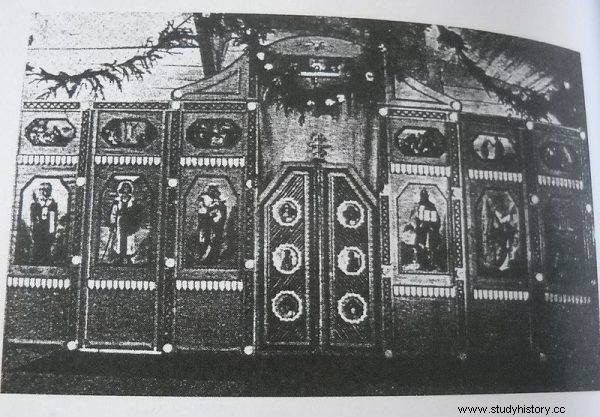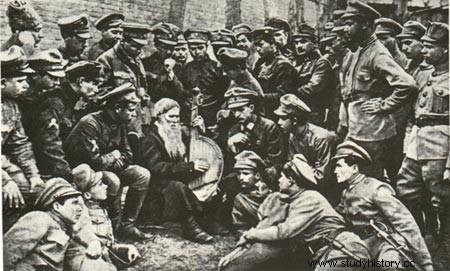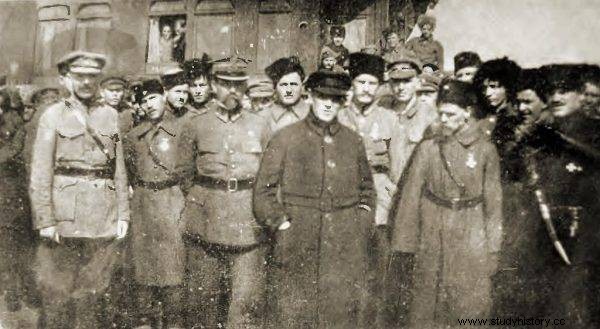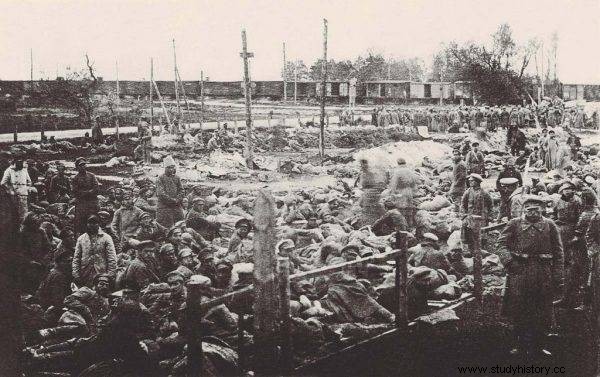At the end of 1920, Poland accepted approx. 30 thousand. soldiers and officers from the army of the Ukrainian People's Republic, Polish ally in the fight against the Bolsheviks.
Together with the Ukrainians, 6,000 soldiers in the group of General Bułak-Bałachowicz, 2,000 Cossacks and almost 6,000 soldiers of the 3rd Russian army who supported Poles and Ukrainians in this fight, also crossed the border.
Alone in the fight
On October 20, 1920, Poland signed a truce with Bolshevik Russia. As a result, the army of the URL and the other formations fighting in Ukraine remained alone in a duel with a strong opponent . In order to sweeten this bitter pill, the authorities of our country decided to extend a helping hand to the allies. They offered ... internment in Poland .
Soon the border of the Republic of Poland was crossed by thousands of Ukrainian and Russian soldiers. They were placed in camps throughout the country:in Kalisz, Kraków-Dąbie, Tuchola, Aleksandrów Kujawski, Łańcut, Strzałków, Wadowice, Toruń, Sosnowiec, and Piotrków Trybunalski.
Aleksandrów Kujawski
In the fall of 1920, the camp in Aleksandrów Kujawski received soldiers from the URL army:900 officers, 2,500 privates, about 100 women and 20 children. They were placed in barracks built by the German army in 1914-1915 . (In Aleksandrów there was a quarantine point for soldiers going to the Reich on vacation).
Inmates undertook extensive cultural activities. In the camp as many as 10 press titles were published, there were theater and gymnastic clubs and a choir . A religious brotherhood was established under the name of st. Pokrov (Protection of the Mother of God). An Orthodox chapel was established in one of the barracks. Iconostasis was made independently; procession banners were embroidered by members of the Union of Ukrainian Emigrant Women.

Iconostasis in the chapel of the internment camp in Aleksandrów Kujawski
In mid-1921, the Ukrainians tidied up the cemetery near Aleksandrów, where the dead from the camp were buried. They fenced the necropolis with barbed wire, covered the graves with turf, and placed the names of those buried there on wooden crosses. They built a mound in the style of a steppe grave and placed a black Zaporizhia cross on it. On the front slope of the mound, they built a sand slab with the inscription: Let the enemy know that the Cossack force / Not yet died under the tyrant's yoke / That every steppe mogła / It's eternal unwrapped wound .
The cemetery was consecrated on September 18, 1921. The ceremony was attended by representatives of the authorities of Alexandrov, Catholic clergy, teachers, residents, as well as all units of the Army of the URL with their commanders residing in the city. The Cossack Tomb became a kind of the Tomb of the Unknown Soldier for the Ukrainian emigrants.
Camp and what next?
In October 1921 the Aleksandrów camp was closed . The interned started a new life in Poland. Some of them settled in Aleksandrów and its vicinity. Their exact number is unknown, but it is known that in 1934 there were about 140 Ukrainians living there . Some have become something of a local celebrity, such as Major Swaryczewski, a fencing teacher at the local gymnasium.

Army soldiers URL
There was a branch of the Ukrainian Central Committee in Poland in the city whose members helped compatriots, among others in the legalization of stay in the Republic of Poland. Thanks to the efforts of the Committee, Christmas trees were arranged for the youngest. In 1933, a nursery for Ukrainian children was opened. At the beginning, only a dozen or so students attended it. Two years later, there were already 35, in 1937 - 65, and in 1938 - 79. The facility operated from spring to autumn. The language, history and geography of Ukraine were taught there.
Piotrków Trybunalski
At the turn of 1920/1921 in Piotrków Trybunalski the smallest camp in Poland was established. In February 1921, 372 military personnel and their family members were there but this number has fluctuated over time. In the fall, as many as 576 people were recorded there.
The dead were buried in the local Orthodox cemetery. There were even attempts to establish their own chapel, but the city authorities ruled that the existing All Saints are able to accommodate additional believers.
Gradually, the number of prisoners began to decrease, because some of the former soldiers went abroad or to larger cities, where it was easier to find employment . A certain group of military personnel, however, decided to stay in Piotrków and its vicinity after finding a job, e.g. in agriculture.
Częstochowa
In the same period there were about 2,000 Ukrainian emigrants in Częstochowa. This group included, among others employees of the state administration of the URL, soldiers from the security services of the Ministry of Military Affairs, 98 officers of the General Staff of the URL, members of the Ministry of the Treasury, staff and patients of one of the field hospitals and medics from the sanitary department of the URL staff. Often, civilians and officers were accompanied by wives and children.

Symon Petlura visits the internment camp in Wadowice
Due to their anti-Bolshevik attitude, the newcomers met with the kindness of local authorities . They could also count on the help of the Ukrainian Red Cross. Over time, many Ukrainians managed to find employment and support themselves and their families on their own. They conducted cultural and educational activities, incl. they set up two kindergartens and a school.
Kalisz
Perhaps the most interesting course was the life of the interned in Kalisz. They were soldiers and officers of the URL and ... Bolsheviks - prisoners of war . The location of the camp was chosen due to the good living and sanitary conditions. During World War I, it was a place of quarantine for German soldiers returning from the Russian front. After regaining independence, the camp was taken over by the Polish authorities. They made it a transfer point for Russians returning to their homeland from German captivity.
The first inmates arrived there at the beginning of December 1920. On February 25, 1921, there were 9,740 interned in the camps in Kalisz and Szczypiorno. Among them, there were 3,772 servicemen from the URL, including 1,098 officers, as well as 178 women and 33 children. However, these numbers were changing dynamically. Among other things, because there were Soviet emissaries in the camps, urging the internees to return to Soviet Russia. Some of the military fell under their promises of a better tomorrow and left for their homeland.

In the camp in Kalisz there were not only interned Ukrainians, but also Bolshevik prisoners of war (illustrative illustration)
Those who decided to stay in Poland conducted extensive cultural and educational activities in order to maintain morale and train cadres for the future Ukrainian army. Three cadet schools were established. Academic Courses for General Staff Officers of the URL were organized, as well as technical and foreign language courses for officers. There was also an intention to create a Military Academy, but the lack of funds stood in the way.
Instead, the gymnasium for them was opened. T. Shevchenko . For over 2,000 soldiers, classes in the history, literature and geography of Ukraine were organized there. 420 privates were taught in primary school, and 300 illiterates were taught to read and write. There was an art studio and cultural associations "Wesełka" ("Rainbow") in the camp. 26 titles of magazines were published, and there was also a 142-member choir.
Ukrainian watchtower
In 1924 the camp was closed. The internees received small financial benefits and had to start an independent life in independent Poland. Among them, however, there was a group of people - disabled, sick, families with children - unable to take care of themselves. They were joined by representatives of the higher command of the Army of the URL. That is why after the camp was closed, the Ukrainian watchtower was established in its separate part.
Its opening took place on August 1. Initially, there were 777 people there, including 247 disabled people with their families, 142 people who were unable to work, and 90 patients, 50 of whom suffered from tuberculosis. In 1926 there were 650 residents, in 1929 - 705, in 1936 - 446. Over time the Stanica was transformed into a "city within a city" . It was an independent center with apartments, a diner, workshops and service establishments, a school, a library and an Orthodox church. It functioned until the outbreak of World War II.
After 1945
For Ukrainian emigrants, who were perceived by the Soviets as enemies, the entry of the Red Army was a danger. NKVD officers arrested many of them. They were sent to the USSR and no trace of them was found. Some former military URLs went to Western Europe, from where they left for the US.
The authorities of the People's Republic of Poland also tried to erase the traces of anti-Bolshevik emigrants, including destroying their burials in Piotrków Trybunalski and Aleksandrów Kujawski.
Bibliography:
- Grzybowski J., In the service of the Republic of Poland:Orthodox military ministry in the Polish Army in 1919-1949 , Warsaw, 2016.
- Waszkiewicz Z., Religious life in the internment camp no. 6 in Aleksandrów Kujawski, "Aleksandrów Kujawski:POWs and interned camps 1918-1921, part 1, Living conditions of prisoners and internees and Ukrainian political emigration Al. Kuj (1918-1922) ", ed. E. Wiszka, Toruń, 2008.
- Wiszka E., Ukrainian emigration in Poland 1920-1939, Toruń, 2005.
- Wiszka E., Press of Ukrainian emigration in Poland 1920-1939, Toruń, 2001.
